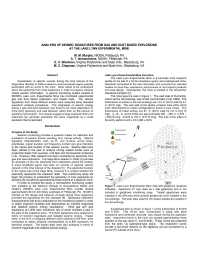Mining Publication: Analysis of Seismic Signatures from Gas and Dust Based Explosions at the Lake Lynn Experimental Mine
Original creation date: February 2008
Examination of seismic records during the time interval of the Sago Mine disaster in 2006 revealed a small amplitude signal possibly associated with an event in the mine. More needs to be understood about the seismicity from mine explosions in order to properly interpret critical seismic information. A seismic monitoring system located at NIOSH's Lake Lynn Experimental Mine has monitored experimental gas and dust based explosions and impact tests. The seismic signatures from these different events were analyzed using standard waveform analysis procedures. The magnitude of seismic energy during a gas and dust explosion was found to be more dependent on mine entry geometry and seal behavior rather than on the amount of explosive fuel present.
Authors: MM Murphy, AT Iannacchione, EC Westman, MC Chapman
Conference Paper - February 2008
NIOSHTIC2 Number: 20033467
2008 SME Annual Meeting and Exhibit, February 24-27, Salt Lake City, Utah, preprint 08-009. Littleton, CO: Society for Mining, Metallurgy, and Exploration, Inc., 2008; :1-7
See Also
- Attenuation and duration of seismic signals generated from controlled methane and coal dust explosions in an underground mine
- Coal-Dust Explosion Tests in the Experimental Mine 1919 to 1924, Inclusive
- Demonstration of Remote Mine Seal Construction
- Progress Toward Improved Engineering of Seals and Sealed Areas of Coal Mines
- Refuge Chamber Expectations Training - 1.0
- Relationship Between Radiated Seismic Energy and Explosive Pressure for Controlled Methane and Coal Dust Explosions in an Underground Mine
- Remotely Installed Mine Seals for Mine Fire Control
- Rock Dusting Considerations in Underground Coal Mines
- Technology News 515 - Float Coal Dust Explosion Hazards
- Technology News 535 - NIOSH Releases New Educational Video: Escape from Farmington No. 9: An Oral History
- Page last reviewed: 9/21/2012
- Page last updated: 9/21/2012
- Content source: National Institute for Occupational Safety and Health, Mining Program


 ShareCompartir
ShareCompartir
